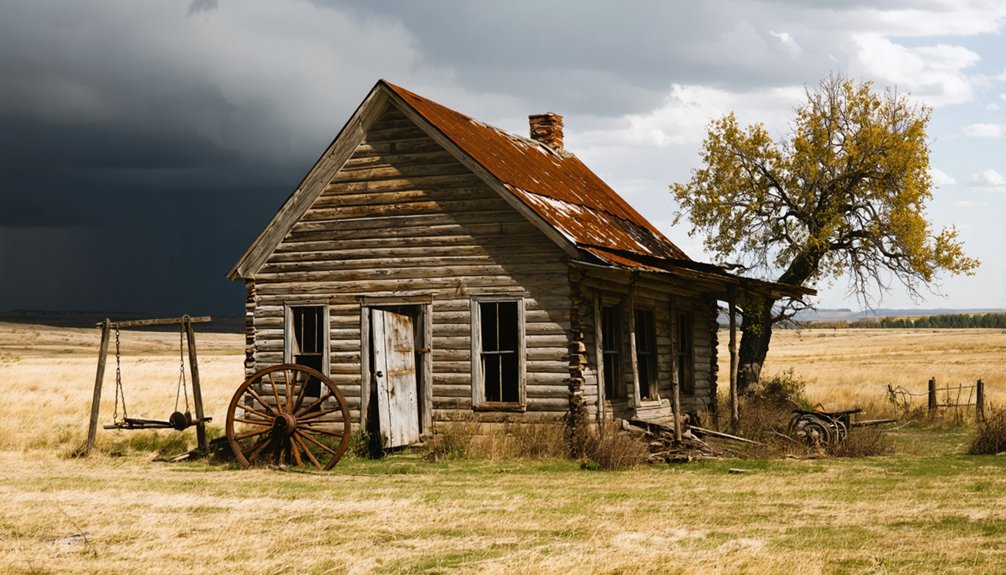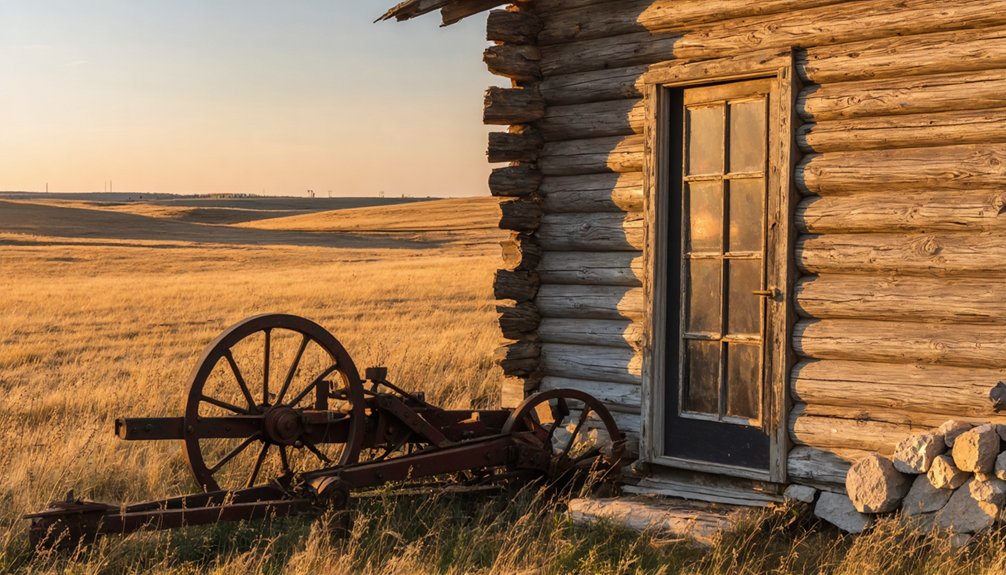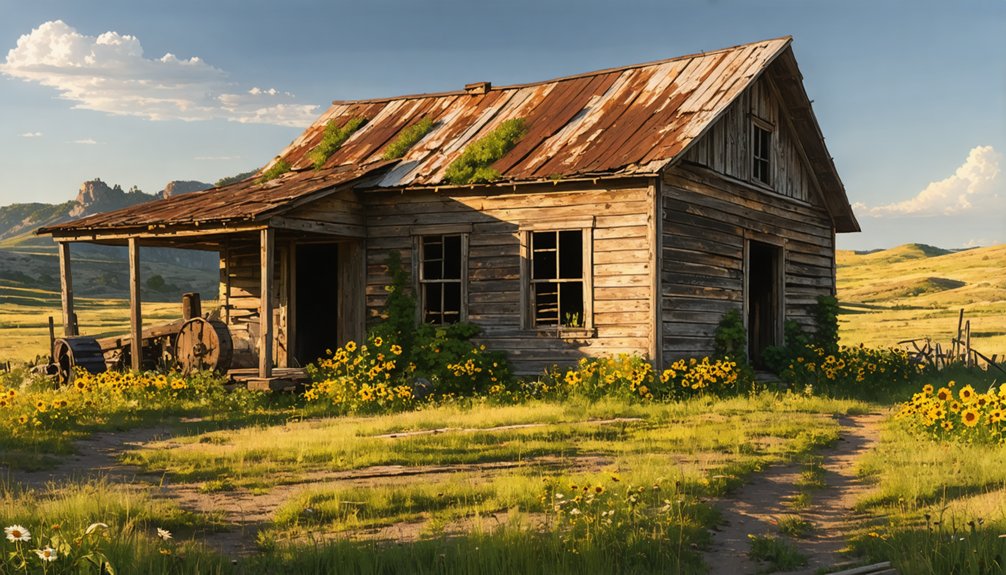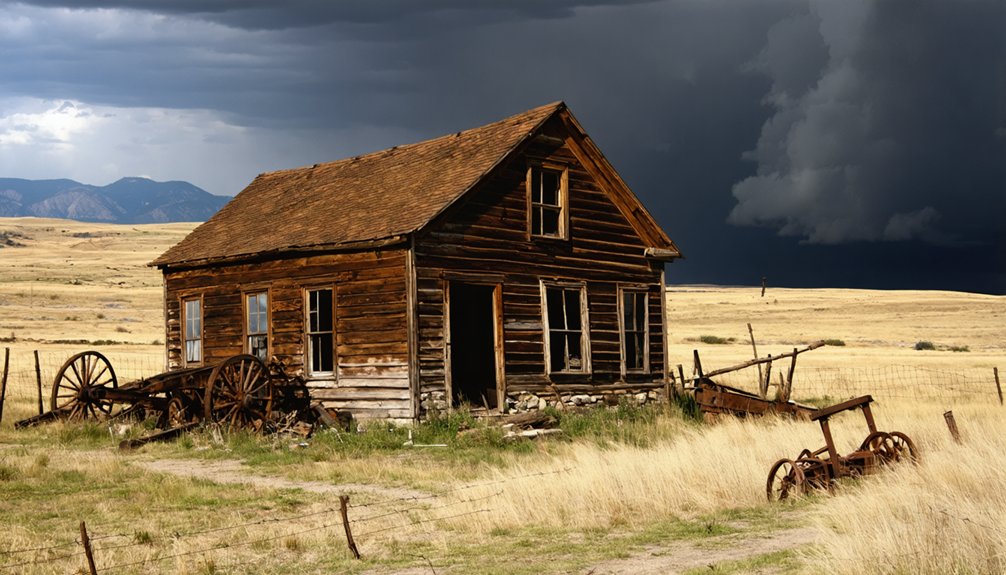You’ll discover Allen’s Camp nestled in South Dakota’s Black Hills, where prospectors struck gold in the mid-1870s near Deadwood. This frontier settlement quickly grew into a bustling hub after the Allen Brothers introduced a pioneering 35-ton cyanide mill for silver extraction in 1900. Today, you can explore the scattered remnants of homes, mining shafts, and artifacts that tell the story of hardy pioneers who faced brutal winters and backbreaking work. The site’s rich history holds countless untold tales of frontier life.
Key Takeaways
- Allen’s Camp was established during the 1870s Black Hills gold rush and later became a significant silver mining operation.
- The camp featured a pioneering 35-ton cyanide mill for silver extraction, expanding to 100 tons by 1901.
- Daily life centered around mining operations, with workers facing harsh conditions and limited access to supplies.
- The site declined when ore deposits became unprofitable, leading to population exodus and infrastructure deterioration.
- Today, visible remnants include building foundations, shaft houses, and scattered artifacts from the mining era.
The Rise of a Black Hills Mining Town
While the Black Hills’ mining history is often associated with Deadwood, the story of Allen’s Camp began amid the region’s gold rush of the mid-1870s.
The town was strategically positioned near the Deadwood-Two Bit District where the first quartz mill emerged in 1876.
You’ll find its origins intertwined with evolving mining techniques, from early placer operations to sophisticated quartz milling pioneered by the Hidden Treasure Mine in 1876. Initial mining claims in the area reached approximately $1.5 million in gold production by 1876.
The town’s fortunes really took off around 1900 when the Allen Brothers revolutionized local mining by introducing a thirty-five-ton cyanide mill.
They weren’t chasing gold like most – instead, they focused on extracting silver from discarded tailings.
The innovation paid off, and you can trace the economic fluctuations as their operation expanded from thirty to hundred-ton capacity by 1901.
The success transformed Allen’s Camp from a modest mining outpost into a bustling industrial hub of the Black Hills.
Life in Allen’s Camp During the Gold Rush
You’d find daily life in Allen’s Camp dominated by the grueling work of placer and hard-rock mining, where prospectors spent exhausting hours sifting creek beds and crushing ore in pursuit of gold.
When you weren’t working your claim, you might seek entertainment in the camp’s numerous saloons and dance halls, which offered brief respites from the challenging labor despite the rough frontier atmosphere. The Homestake Mine discovery in 1876 drew even more miners to the region, hoping to strike it rich in similar hard-rock deposits.
Living in makeshift shelters and tents, you’d face constant battles against harsh weather, diseases from poor sanitation, and the ever-present challenges of securing clean water and reliable food supplies. The arrival of Wild Bill Hickok in June 1876 brought additional excitement and notoriety to the bustling mining region.
Daily Mining Camp Routines
During the peak of Allen’s Camp’s gold rush era, miners endured grueling daily routines that stretched from dawn until dusk.
You’d find camp organization centered around essential tasks, with teams dividing into prospectors, excavators, and mill operators. Water sources dictated camp locations, while makeshift tents and wooden shacks served as shelter near claim sites. The Homestake Mining Company established operations nearby in June 1876.
Labor roles demanded constant physical exertion, from panning creeks to crushing ore in stamp batteries. The average miner was only 22 years old, reflecting the youthful energy needed for such backbreaking work.
You’d spend your days maintaining tools, repairing sluice boxes, and hauling heavy equipment by horse-drawn wagon across rudimentary roads.
When working the mines, you’d face dangers like cave-ins and mercury exposure with minimal safety measures.
The quest for gold meant pushing through harsh weather and dangerous conditions, often sacrificing comfort and health for the promise of striking it rich.
Social Life and Entertainment
Despite the harsh realities of mining life, Allen’s Camp fostered a vibrant social scene where prospectors found refuge in makeshift saloons, gambling halls, and occasional theatrical performances.
You’d have found yourself caught up in lively card games, sharing tales of the day’s mining fortunes over whiskey, or dancing to the tunes of traveling musicians in crowded tents. Local establishments were similar to those in nearby towns like Galena, which had multiple boarding houses and saloons.
Community events brought together miners from diverse backgrounds, creating bonds that transcended ethnic differences. Some miners celebrated their fortunes from the Homestake Mine discovery, which became one of the world’s most productive gold mines.
You might’ve attended impromptu religious services, celebrated cultural festivals, or gathered around campfires to hear stories of legendary figures like Calamity Jane.
Entertainment venues, though crude by today’s standards, served as the heart of social life, where successful prospectors flaunted their newfound wealth while others sought escape from the grueling work of the mines.
Survival Against Harsh Elements
While the promise of gold lured thousands to Allen’s Camp, the harsh realities of Black Hills survival quickly tested even the most resilient prospectors.
You’d need more than just mining tools to endure here – survival strategies became just as vital as your ability to find gold. Harsh winters brought deep snow and bitter cold, forcing you to fortify simple log cabins with whatever insulation you could find, from animal hides to packed dirt between logs.
You couldn’t make it alone in Allen’s Camp. Survival meant sharing resources with fellow miners, from firewood to food stores. Following the example of the Gordon Party’s stockade, miners built fortified shelters to protect against the elements.
When supplies ran low, you’d rely on hunting, though game was scarce in winter. The community banded together, establishing informal governance and trading networks that helped everyone weather nature’s challenges.
Mining Operations and Economic Impact
As the Black Hills mining boom reached its later phases, Allen’s Camp emerged as a pioneering site for silver extraction when the Allen Brothers and Soule established their groundbreaking thirty-five-ton cyanide plant in 1900.
They’d revolutionized the local industry by applying cyanide processing to recover silver from old tailings – waste material that previous operations had discarded during the 1880s.
You’ll find the operation’s impressive growth reflected in their rapid expansion, as milling capacity tripled from 30 to 100 tons by 1901.
While primarily running during summer months, the camp’s innovative approach to tailings recovery proved profitable, building upon the area’s earlier success when nearby Ragged Top Mountain’s gold lodes yielded over 15,000 ounces between 1896 and 1899.
This resourceful mining strategy helped sustain the local economy even as richer ore deposits declined, similar to how the Standby Mill operated until 1942 during challenging economic times.
Daily Challenges of Frontier Settlement

The settlers of Allen’s Camp faced challenges far beyond the technical demands of mining operations. You’d have found yourself confronting harsh environmental conditions that tested your resilience daily – from brutal winters that could freeze you to your bones to scorching summers that withered crops in the fields.
Isolation challenges meant you couldn’t just run to town for supplies; every necessity had to be carefully planned and rationed.
Living miles from civilization forced pioneers to meticulously plan their resources, as the nearest store could be weeks away.
These settler struggles touched every aspect of life. You’d have spent countless hours performing backbreaking labor, from hauling water to preserving food for winter.
When illness struck, you’d have relied on home remedies since doctors were often days away. Your survival depended on self-sufficiency and the occasional help of neighbors, who might’ve lived miles from your homestead.
The Path to Abandonment
Despite its promising beginnings, Allen’s Camp’s decline into abandonment followed a pattern familiar to many frontier mining settlements.
You’ll recognize the telltale signs: as the local ore deposits became less profitable, the mine’s economic viability plummeted. The town’s remote location and poor roads made it increasingly difficult to transport essential supplies and equipment, driving up operational costs.
When the mines began closing, you’d have witnessed a swift population migration as miners and their families sought opportunities elsewhere. The younger generation, especially, moved to urban areas for better prospects.
Without its economic backbone, the town’s infrastructure crumbled. Environmental hazards from mining operations, including dangerous open shafts and contaminated water sources, made the area increasingly unsuitable for alternative development or resettlement.
Preserved Remnants and Historical Artifacts

Today’s visitors to Allen’s Camp can still discover tangible links to its mining past through scattered remnants and artifacts that paint a vivid picture of frontier life.
You’ll find foundations of former homes and businesses, while weathered shaft houses and ore bins mark where miners once extracted Black Hills gold. Evidence of daily life emerges through fragments of ceramics, bottles, and personal items that historical documentation efforts have helped preserve.
Weathered buildings and scattered artifacts silently chronicle the lives of Black Hills miners who once called this rugged landscape home.
The challenge of artifact conservation grows as nature reclaims the site. Metal structures shine with corrosion, wooden markers fade, and vandalism threatens what remains.
Yet the tailings piles, tramway ruins, and water management systems still tell compelling stories of engineering ingenuity and community perseverance in this remote mining outpost.
Exploring the Ghost Town Today
Located deep within the Black Hills region of South Dakota, Allen’s Camp beckons modern explorers to venture along gravel and forest service roads that wind through rugged terrain.
You’ll need to prepare for ghost town exploration by bringing appropriate hiking gear and consulting detailed maps, as signage is minimal and roads aren’t well-maintained.
As you navigate the site, you’ll discover stone foundations and mining remnants hidden beneath years of natural reclamation.
Keep your camera ready but watch your step – the area contains hazards like old mine shafts and uneven ground.
Remember to inform someone of your plans before visiting, as the location is remote.
While exploring, you’re free to document the historical remnants, but practice Leave No Trace principles to preserve this piece of mining heritage for future adventurers.
Legacy of the Black Hills Mining Era

While abandoned sites like Allen’s Camp tell individual stories of frontier dreams, they’re part of a broader historical tapestry woven during the Black Hills gold rush that began in 1874.
You’ll find that this era transformed not just the landscape but the entire region’s destiny through advancing mining technology, from simple placer methods to sophisticated hard rock extraction and chemical processing techniques.
Yet this period of innovation and wealth came at a devastating cost. The rush violated the Fort Laramie Treaty with the Sioux, sparking conflicts that echo into present-day indigenous rights discussions.
When the U.S. Supreme Court ruled in 1980 that the government had illegally seized the Black Hills, the Sioux rejected monetary compensation, standing firm in their demand for the return of their sacred lands.
Frequently Asked Questions
Are There Any Documented Supernatural Occurrences or Ghost Stories From Allen’s Camp?
You won’t find documented ghost sightings or haunted tales from this location, as historical records focus purely on mining activities and settlement ruins rather than supernatural phenomena in the area.
What Wild Animals Commonly Inhabit the Ghost Town Ruins Today?
You’ll spot wildlife sightings of mule deer, coyotes, and raccoons among the ruins, while animal tracks reveal visits from hawks, owls, rattlesnakes, and various small mammals seeking shelter.
Was There Ever a School Built in Allen’s Camp?
Like a fading photograph in time, you’ll find no solid proof of a school’s existence at this site, though the area’s education legacy includes Charles Wesley Allen’s work with Pine Ridge children.
Did Any Famous Outlaws or Historical Figures Visit Allen’s Camp?
You won’t find evidence of famous visitors or outlaw legends at this site. While the Black Hills attracted notable figures, there’s no documented proof they specifically visited Allen’s Camp.
What Native American Tribes Originally Inhabited the Allen’s Camp Area?
Like ancestral footprints in sacred soil, you’ll find the Lakota Sioux were the primary inhabitants of this land, with the Cheyenne Tribe also maintaining historical presence in the Black Hills region.
References
- https://www.sdpb.org/rural-life-and-history/2023-08-21/some-black-hills-ghost-towns-and-their-origins
- https://blackhillsvisitor.com/learn/carbonate/
- https://www.sdhspress.com/journal/south-dakota-history-2-2/some-black-hills-ghost-towns-and-their-origins/vol-02-no-2-some-black-hills-ghost-towns-and-their-origins.pdf
- https://www.blackhillsbadlands.com/blog/post/old-west-legends-mines-ghost-towns-route-reimagined/
- https://www.truckcampermagazine.com/expeditions/united-states/exploring-ghost-towns-with-a-camper/
- https://en.wikipedia.org/wiki/List_of_ghost_towns_in_South_Dakota
- https://www.youtube.com/watch?v=4On6Nke3ANg
- https://973kkrc.com/south-dakota-underwater-ghost-town/
- https://blackhillsvisitor.com/learn/pactola/
- https://www.mininghistoryassociation.org/Journal/MHJ-v26-2019-Henris.pdf



